BN125-A5,
VN250-B1, El252, EN500-C5, VN750-A16, VN800-A6, VN800-B5,
VN1500-N1, VN1500-E3,
VN1500 2000-L1, VN1500-G2A, VN800-C2, VN1500-J2,
VN400-D2
| |
| |
|
|
|
|
|
|
|
|
|
| |
 |
Eliminator 125 or BN125 ,
Model name BN125-A5 |
|
| |
Perfect for the beginning rider
who wants an easy-to-operate motorcycle with a low seat height,
the Eliminator 125 is also inexpensive to buy and maintain. It
is powered by an air-cooled, 125cc, four-stroke, single-cylinder
engine specially tuned for low- and mid-range torque, making it
perfect for around-town riding. The electric starter makes
getting under way easy and a convenient five-speed transmission
allows the rider to use the engine's full potential.
 |
 |
|
 |
 |
|
| |
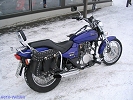 |
|
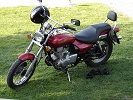 |
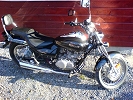 |
|
| |
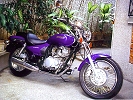 |
BN175 Eliminator.
In some Asian countries, there is a beefed up version of the
eliminator, a whole 50cc more, called the 175 Eliminator. |
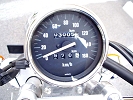 |
|
|
|
|
|
|
| |
|
|
| |
VN250
Eliminator (Model name VN250-B1) and EL252 Eliminator |
|
| |
The VN250V and
EL252 Eliminator's was
Kawasaki's entry level, learner legal street rods in the year
2000. With all the looks and size of the bigger boys, it's hard
to believe that it is only a 250. The VN250 have a V-2
engine and the EL252 is a inline twin. The EL252 have been
around for years. The VN250 got an all black engine for 2000. |
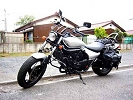 |
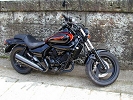 |
Sorry for the low quality
pictures, but good ones are hard to find. |
|
 |
 |
|
| |
 |
< VN250 , EL252 > |
 |
Galaxy Silver |
Candy Sungod Orange /
Ebony |
|
|
El252 |
El252 |
|
| |
|
|
| |
EN500 Vulcan
Model name EN500-C5 |
|
| |
The EN500 is the same bike as last year, actually
not much have been changed sins the introduction in 1996.
Only the color
is new, and why change a great bike. Powered with an well known engine from
the GPZ500 (Ninja 500) and designed like its bigger Vulcan brothers. A
good bike for the beginner and for the experienced rider. |
 |
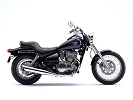 |
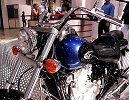 |
|
|
 |
|
| |
|
|
| |
VN750Vulcan Model name VN750-A16 |
|
| |
The Vulcan 750, this bike was big news in 1985 and
now 15 years later its still around. Powered by a liquid-cooled,
double-overhead-cam 749cc V-twin. Hydraulic valve lash adjusters automatically keep the
eight-valve cylinders at optimum adjustment, eliminating unwanted valve noise.
Liquid cooling increases overall engine durability. A low-maintenance shaft drive conveys power from the five-speed transmission
to the beefy 15-inch rear wheel. Air-assisted rear shocks with four clicks of
rebound damping adjustment offer a smooth and controlled ride, while dual front
discs provide reliable stopping power.
|
 |
|
|
|
 |
|
| |
|
|
|
|
|
|
|
|
|
|
|
| |
| |
|
|
|
|
|
|
|
|
| |
VN800Vulcan and VN800Vulcan Classic.
Model name VN800A6, VN800B5 |
|
| |
VN800 and VN800
Custom. Two bikes with a lot in common. The VN800 have a big 19
inc. front wheel and a swept rear fender, the Classic have fat
16 inc tires all around and big fenders front and rear.
Bothe share the same frame, tank and engine. The powerhouse is a
V2 a little over 805cc. Its liquid cooled, but looks air cooled.
Like many Kawasaki from this area its quite old, the VN800
appeared first in 1995 and the Custom nest year |
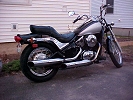 |
 |
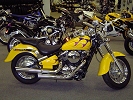 |
 |
 |
|
| |
 |
|
VN800 |
VN800Custom |
|
| |
|
|
| |
VN1500Vulcan Classic.
Model name
VN1500 N1 (Fuel injection)
VN1500
E3 |
|
| |
The VN1500 Classic continues this
year, it was born in 1996 and have had some updates during it
life. In the year 2000 you could have it in two versions, with
or without Fuel Injection. The carbureted version use
two Keihin CVK40carburetors and for 2000 the colors are new.
The Vulcan 1500 Fuel Injected (Nomad, Classic and Drifter) have
dual
36 mm throttle bodies. There are new
pistons with higher compression (up from 8.6:1 to 9.0:1), power
is increased with 2hp. Some minor changes have been done to the
engine to improve noise level. Other changes are a
change from a cable-driven speedometer to
an electric unit. By eliminating the deep housing the
speedometer needed and the cable that passed through the bottom
of the tank, Kawasaki found enough room for almost an extra
gallon of fuel (from 4.2 gallons to 5.0 gallons) in the same
space. The new speedometer features a digital odometer,
trip meter and clock, and the tank is now seamless, eliminating
the unsightly external flanges.
Several updates were also made to the chassis. The frame's
main pipes have increased diameter (42.7mm
up from 34mm),
a larger diameter steering head with bigger bearings and new
gussets offer more rigidity. The steering head was moved forward
(35mm) and fork offset decreased for improved handling.
Consistent with design enhancements of the 2000 Vulcan 1500
Nomad and Drifter motorcycles, the Classic Fi's floorboards have
been repositioned to put the rider in a more upright and
comfortable position. The rear brake pedal was also redesigned
to make it easier to apply the brake that now has more power due
to a new dual piston calliper. Other items adopted from the
Nomad and Drifter are wide, five-way adjustable brake and clutch
levers for added rider comfort and self-cancelling turn signals.
Other changes include an upgrade from a 12V-14Ah battery to a
12V-18Ah unit (while retaining the same physical size), a low-fuel warning light
replaces the petcock and a new multi-pane headlight provides a brighter, more
concentrated beam. A new, self-canceling turn-signal system is now used and the
spokes have a special coating on them to make sure they stay shiny longer. |
 |
 |
Left VN 1500 Classic. |
|
| |
Right and below VN1500 Classic FI |
 |
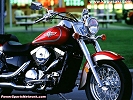 |
|
| |
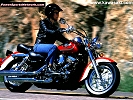 |
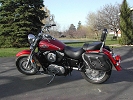 |
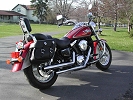 |
|
| |
|
|
|
|
| |
|
|
|
|
| |
VN1500Vulcan Nomad
Model name
VN1500 2000 L1 (Fuel injection)
VN1500
G2A |
|
| |
The VN1500 Nomad, based on the
VN1500 Classic with additional touring equipment like windscreen and hard
luggage. Like the Classic you can get the engine with or without
electronic fuel injection. For 2000 the Nomad got the same updates as the
Classic FI, see above. |
|
 |
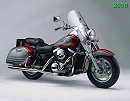 |
 |
 |
 |
|
| |
Specifications all
VN1500 models |
|
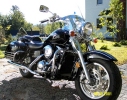 |
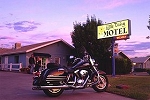 |
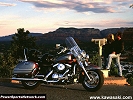 |
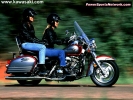 |
|
|
 |
| |
|
|
|
|
|
|
|
|
|
|

|
